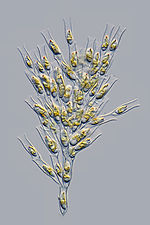Prymnesium parvum is a species of haptophyte (also collectively called Prymnesiophyta). The species is of concern because of its ability to produce the...
5 KB (668 words) - 16:34, 17 August 2024
Prymnesium is a genus of haptophytes, including the species Prymnesium parvum. The genus is a unicellular motile alga. It is ellipsoidal in shape one...
8 KB (601 words) - 13:27, 2 March 2024
the prymnesins, a class of hemolytic phycotoxins made by the alga Prymnesium parvum. It is known to be toxic to fish, causing mass fish deaths around...
6 KB (461 words) - 05:57, 28 November 2024
Golden algae is also commonly used to refer to a single species, Prymnesium parvum, which causes fish kills. The Chrysophyceae should not be confused...
16 KB (1,593 words) - 14:20, 3 January 2025
prymnesins, a class of ladder-frame polyether phycotoxins made by the alga Prymnesium parvum. It is known to be toxic to fish. It is a so called "B-type" prymnesin...
6 KB (311 words) - 08:42, 16 October 2024
die-off. According to them, it was caused by golden algae (likely Prymnesium parvum, which prefer warm salty alkaline waters). Researchers at the Leibniz...
31 KB (2,628 words) - 19:36, 1 February 2025
Prymnesin-2 is an organic compound that is secreted by the haptophyte Prymnesium parvum. It belongs to the prymnesin family and has potent hemolytic and ichthyotoxic...
12 KB (1,147 words) - 15:19, 28 November 2024
"Identification of a Kdn biosynthesis pathway in the haptophyte Prymnesium parvum suggests widespread sialic acid biosynthesis among microalgae". Journal...
29 KB (3,328 words) - 14:47, 2 November 2024
include Clostridium saccharoperbutylacetonicum, Sargassum, Gracilaria, Prymnesium parvum, and Euglena gracilis. Light is what algae primarily need for growth...
105 KB (11,904 words) - 13:20, 22 January 2025
other fish species contain toxins. Toxin-producing algae include Prymnesium parvum. It was discovered that euglonophycin, a euglenoid ichthyotoxin derived...
4 KB (466 words) - 22:50, 3 December 2023
had a higher than normal salt content allowed the proliferation of Prymnesium parvum, a species of algae responsible for the 2022 Oder environmental disaster...
23 KB (2,090 words) - 13:14, 11 November 2024
and the capacity to ingest prey. Ochromonas species Ochromonas spp. Prymnesium parvum Dinoflagellate examples: Fragilidium subglobosum,Heterocapsa triquetra...
133 KB (10,590 words) - 01:51, 21 October 2024
nutrients space. Some evidence of competitive effects: Graneli showed that Prymnesium spp. will produce phycotoxins which kill competitors under nitrogen or...
27 KB (2,521 words) - 15:56, 11 July 2024
Israel. He showed that growth of a toxic unicellular phytoflagellate—Prymnesium parvum and the synthesis of their toxins have different optimal requirements...
7 KB (927 words) - 03:48, 5 February 2025
Eurasian Water-Milfoil Potamogeton crispus Curly Leaved Pondweed Prymnesium parvum Golden Algae Salvinia molesta Giant Salvinia Trapa natans Water Chestnut...
14 KB (144 words) - 15:47, 29 October 2024
and the capacity to ingest prey. Ochromonas species Ochromonas spp. Prymnesium parvum Dinoflagellate examples: Fragilidium subglobosum,Heterocapsa triquetra...
232 KB (21,388 words) - 01:23, 27 November 2024
copepods such as Acartia tonsa and rotifers. The mixotrophic flagellate Prymnesium parvum is a prey item for O. marina when the former is nutrient-replete,...
13 KB (1,549 words) - 21:10, 24 October 2024
bloom that resulted in fish kills. The algae was identified to be Prymnesium parvum, a golden algae that produces toxins fatal to animals with gills....
4 KB (296 words) - 21:09, 1 June 2024
Professor Carl Reich and others, he discovered a new species of algae (Prymnesium parvum) in 1946 and identified it as the cause of fish mortality in fishponds...
7 KB (619 words) - 09:44, 4 November 2024
that these species are closely related to Gephyrocapsa huxleyi and Prymnesium parvum which are both primary producers. As members of the Haptophyte clade...
7 KB (701 words) - 09:09, 30 September 2024













